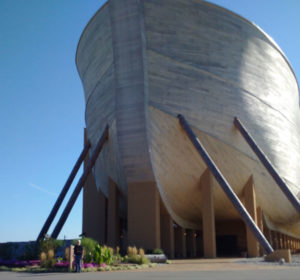On August 9, 2017 I visited the new Theme Park/Exhibit called The Ark Encounter in the Cincinnati area, in Kentucky. The Answers In Genesis (AIG) ministry has built a full size replica of Noah’s Ark for people to visit.
 Caption: I stand perhaps 150 yards from the AIG Ark Encounter near Williamstown, Kentucky.
Caption: I stand perhaps 150 yards from the AIG Ark Encounter near Williamstown, Kentucky.
The dimensions of the Ark from Genesis (see the KJV or NKJV Bible)
Length: 300 cubits
Width: 50 cubits
Height: 30 cubits
As built by Answers In Genesis (20.4 inches per cubit, or 1.7 ft./cubit)
Length: 510 feet
Width: 85 feet
Height: 51 feet
Cost: Approximately 100 million dollars
I believe Adam, Eve, Methuselah, Noah, and others mentioned in Genesis 1-11 were real people and that the global Flood was a real event in the time of Noah. The Ark Encounter from Answers In Genesis is a great place to visit. Everything is well done and there are activities to do outside the Ark itself, such as a zip line ride and a small zoo. There are a number of small shops to get crafts and snacks. There is also a very nice restaurant that has a marvelous buffet that is able to handle a large crowd. On the Ark itself is 3 levels of exhibits. It took my friend and I perhaps something over 5 hours to see everything. You realize how big the Ark is as you walk to see it all. It really is a lot of walking. The Ark Encounter is built almost totally of wood. It is said to be the largest timber-framed wooden structure of its kind in the world. It uses 1.5 million board feet of heavy timber. Some of the building methods followed those used by Amish builders, who are experts in building wood structures. The back side of the Ark is connected to a building made with modern typical construction methods which includes the elevators and restroom areas. The Ark is also set 15 feet above ground on special concrete piers. Inside, there are areas that demonstrate how various kinds of animals could be housed and managed inside the Ark as well as how Noah’s family would live. There are two theater areas inside the Ark. Though the structure is wood, the displays and exhibits are very high-tech. Some exhibits were created using 3D printing technology. I would say the exhibits essentially answer all the common questions people have about Noah’s Flood and Noah’s Ark.
As we were arriving to the Ark Encounter, it occurred to me that what Christians were doing today in visiting the Ark today in Kentucky is much like when Noah was building the original. Noah spent years building the structure and had to solve many challenging problems to do it. He must have done it outside of cities of the time, in order to have space and wood to do it. People probably came out to see it, even if just to laugh at Noah. This is like today, when people visit the Ark. Some come with family though they don’t believe it, and so they see the faith of others and they wrestle with what faith in the God of the Bible means. The gospel is presented at the Ark Encounter in multiple ways, so it really is a good place to bring non-christian friends or family. So people go outside of Cincinnati today to see the Ark (south of Cincinnati near Williamstown, KY). The people of Kentucky and Cincinnati know the Ark is there and so it is a witness that points to the faith of Christians who believe the Bible is literally true. There are still people who believe the book of Genesis tells us real history, even today in 2017. This faith is not outdated or misplaced, nor is it wishful thinking. The Ark Encounter exhibits demonstrate reasonable answers to the questions people have, in order to remove obstacles to people believing in Christ. So, Christians demonstrate their faith today in going to see the Ark. We don’t actually know how Noah and his family solved all the problems of living on the real Noah’s Ark, but this is not a problem. If we can come up with reasonable answers to the questions today, then Noah could have found reasonable answers to the problems then.
 Caption: Front end of the Ark. Friend Mark stands near it.
Caption: Front end of the Ark. Friend Mark stands near it.
The Ark Encounter affirmed many things that I have taught about Noah’s Flood and Noah’s Ark over the years. But I also learned a number of things in my Ark encounter. I learned about extinct animals I had never heard of because the exhibits showed replicas of a number of extinct animals, that would have been on the real Ark. I learned about methods of removal of waste from the Ark and ventilation of the Ark that would be feasible for Noah’s family to use on-board the Ark. I learned that the number of animals needing to be on-board the Ark could have been less than I had expected (about 6,700 by AIG research). In a number of ways, Noah’s family had to find ways to “work smarter, not harder” to manage caring for the animals. The Ark Encounter helps visitors find answers to their questions on the Flood. The Ark Encounter also helps people imagine the corruption of the preflood human society, where people lived at the same time as dinosaurs. Geological evidence for the Flood, the cause of a post-flood ice age, and other scientific questions were addressed also. Reasonable well-informed answers are provided. Granted some of the exhibits are based on speculative reconstructions, but demonstrating that this can be done today implies it is plausible Noah and his family could have done it in the past.
The Answers In Genesis Ark structure is not the first replica of Noah’s Ark that has been built, but it is probably the most authentic. In 2012 CNN did a story about a man in Dordrecht, Netherlands who built a replica of Noah’s Ark. It has been called Johan’s ark, after Johan Huibers, the man who built it. Johan is a wealthy businessman. He built it to be a “Bible museum.” Huibers did not have the means to built an ark in an authentic way. He put barges together and then put wood around it. Huibers did make it the Biblical dimensions but he seems to have used a smaller value for the length of a cubit than Answers in Genesis, if the CNN article is correct.
In Bremerton, Washington there is a Noahs Ark Restaurant, but it is not built as a replica of Noah’s Ark, it is more of a theme of the restaurant. There have also been a number of churches built to be similar to Noah’s Ark. Churches have always considered it as a salvation message, that Jesus is like “our Ark” and the one way to be saved.
There has also been ship engineers and naval architects who have studied Noah’s Ark. Some have made small scale engineering models and studied them in wave tanks. The late Henry M. Morris showed that the dimensions of the Ark made it almost impossible to capsize in the water. The engineering studies have consistently shown the unique proportions of the Ark from scripture make it quite stable in the water. Another study by a mechanical engineer (from the 2013 International Conference on Creationism) looked into whether immersion in water for extended periods of time would weaken the structural strength of the Ark. The conclusion was that any weakening effect was not great enough to threaten the structural integrity of the Ark.
In our modern world, where Bible stories are often thought of as like myths or legends, the Ark Encounter shows that we can believe the Bible is really true. Much attention to detail in the exhibits demonstrate how a family like Noah’s long ago might have managed all the challenges and lived through the experience. The sight of the AIG Ark structure is very impressive. It will undoubtedly spark much conversation about the Bible and the book of Genesis. The key issue brought up by the Ark Encounter is probably the authority and historicity of Genesis in the Bible. The Ark Encounter is a quality attraction that I highly recommend.
 Caption: Noah reaches to catch the dove to return him to his cage.
Caption: Noah reaches to catch the dove to return him to his cage.
Website from Tim Lovett and others on the engineering of the Ark.
http://worldwideflood.com
